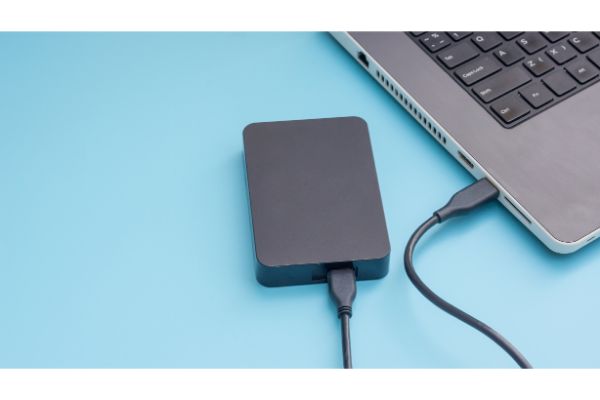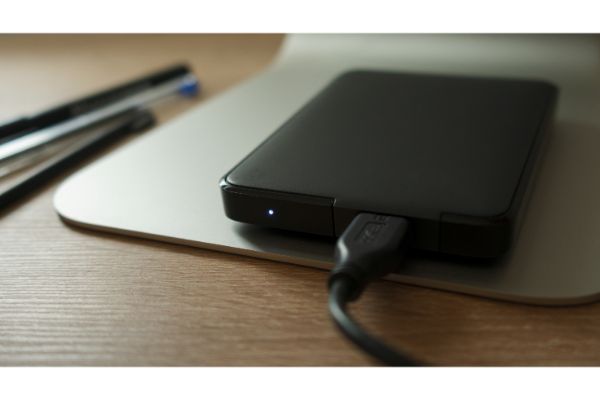Disclaimer: This post may contain affiliate links, meaning we get a small commission if you make a purchase through our links, at no cost to you. For more information, please visit our Disclaimer Page.
External hard drives make data storage very convenient. Even for high-capacity drives, you can get models you like at relatively inexpensive price points. They are small, portable, and ready-to-use. Most of all, they boot up instantly when you connect them to any device with the same port interface.
Despite their size, you can store terabytes of data and access them wherever you go. Also, you don’t need to do anything to set them up to interface with computers. Instead, these drives function like the internal ones found on desktops or laptops.
While the typical external hard drive is relatively simple to figure out, some people may still have questions about how they can use theirs. Therefore, we will try to answer some questions that might be less common in the tech community.
As we dive in, we will discuss whether you can unplug an external disk without ejecting it from the computer. Then, we’ll figure out if it is okay to shut down your computer entirely with such a drive still connected to it. We will also talk about ejecting the drive before a shutdown procedure and if it makes any difference to remove a drive while leaving it plugged into a port.
Finally, before we wrap things up, we’ll also troubleshoot some possible issues you might experience with external drives. These topics will include problems with heat retention and usual usage.
Table of Contents
1. Can You Unplug an External Hard Drive Without Ejecting?
Technically, you can unplug an external drive without ejecting it beforehand. But, before we continue, let’s define ” eject ” from a technological viewpoint. In this case, “eject” does not mean physically removing a disk. Instead, it is a process that the computer goes through.
If you click on the options for your external hard disk, one of them will tell it to eject. When you click it, it sends a signal to the hard drive. Before disconnecting from the computer, the drive will complete all necessary write operations. It will take any cached jobs in its memory and finish writing them to the drive’s storage before it ejects.
Once the external drive completes these steps, it stops the operations and parks the drive heads. After that, it is safe to remove the external drive without any fear of data loss.
That said, most modern external drives can quickly park their heads. Therefore, most models should be okay to remove without telling them to eject. The drive will spin down without losing or corrupting data after removing it. However, it is essential to keep some caveats in mind here.
First, you should never remove a drive in the middle of an actual file transfer. The ejection process aims to ensure that the drive can finish its job before it stops.
While you should have no trouble disconnecting a drive manually, you risk file corruption if you interrupt the drive. In addition, you might experience issues with the entire storage system from that point onward.
2. Can I Shut Down My Computer With an External Hard Drive Still Plugged In?
In most cases, it should be safe to shut down your computer while connected to the external unit. However, it comes with some warnings.
Leaving the drive plugged into the computer is fine if you do a standard shutdown procedure. During this process, you tell your computer to shut off entirely from the power options it’s connected to. In doing so, all the drives, including the external ones, will park and shut down safely. It also reduces the risk of any data loss on your drives.
If you shut down your system using any other method, such as holding the power button or unplugging the power cord, eject and unplug the external unit first.
3. Do I Need To Eject the External Hard Drive Before Shutdown?
No. You don’t need to eject the external drive before initiating a shutdown. Much like your computer’s internal hard drive, the external one will spin down and park itself. It may still spin, make noise, or draw some power for a bit after the primary system shuts down ahead of it. However, it should quiet itself entirely after some time.
Although most modern drives should not pose any issues like this, your operating system may get confused if you shut down your computer without ejecting any external drives first. In addition, some older operating systems may have bugs that relate to USB usage. If this is the case, your computer might fail to boot if it has a USB device.
It won’t be a problem for newer OS versions, but readers running older systems may wish to keep it in mind. For these systems, the only way to fix such a problem is to eject or unplug the external disk before rebooting the main computer.
On a related note, you may run into an issue when the computer tries to boot from the external drive. Because you probably didn’t set up the new drive to handle something like this, you will have similar problems with starting your operating system.
To fix this, enter your computer’s BIOS on startup and check which drive is bootable. Then, you can change it to your primary disk drive instead of the external one.
If you find that either of these problems crops up for you, change the USB port you’re using to connect your computer to your external disk. Some older motherboards do not have the bugs we referenced earlier, and using a 2.0 port might solve the issue.
4. Is It Normal for an External Hard Drive To Get Hot?
Hard drives spin because they transfer files or access data. Most external drives are small accessories with hardware packed into a closed frame. Thus, it’s normal for these disk drives to get somewhat warm during regular operations.
We could debate how hot might be too hot, but you may have problems if your external unit feels hot enough to be uncomfortable when you touch it. If you experience this, there is a good chance that it might be overheating.
Overheating is one of the most common causes of drive failure. And most external disks don’t get hot and stay that way usually. But there are some things you might be able to do to mitigate the risks in this situation.
First, purchase your drives from reputable brands. Data storage is relatively cheap these days, and getting a mid-range unit in terms of quality makes sense. In contrast, a cheaper brand will most likely have inferior parts. And that could contribute to the unit overheating later.
Even if your external disk from a reputable brand seems a little too hot, here are some tips to keep it cool:
- Purchase a low-power USB fan accessory on which you can set the drive to help it stay cooler.
- If you need to do long sessions of data transfer, take breaks to give your disk a rest.
- Use your computer and its accessories in an area with good ventilation.
5. How Often Should External Hard Drives Be Replaced?
The average life span of external hard drives is at least three years. With quality parts, and assuming that you place no undue hardship on the unit throughout its lifetime, it should last at least this long.
On the outside, many companies will say that their products in this category should last up to five years. However, there is no hard rule governing external disk life. Some may fail unexpectedly within a couple of years. Others can last for decades. As a rule, you may wish to back up any crucial data yearly.
Conclusion
External hard drives can store many files quickly, and their writing speeds mean you don’t have to spend much time transferring data from one place to another. They are also easy to use, and you should be able to leave them plugged in when shutting down your computer. In most cases, you can also unplug them without ejecting them. Meanwhile, you may check other questions about external hard drives in our blog.


